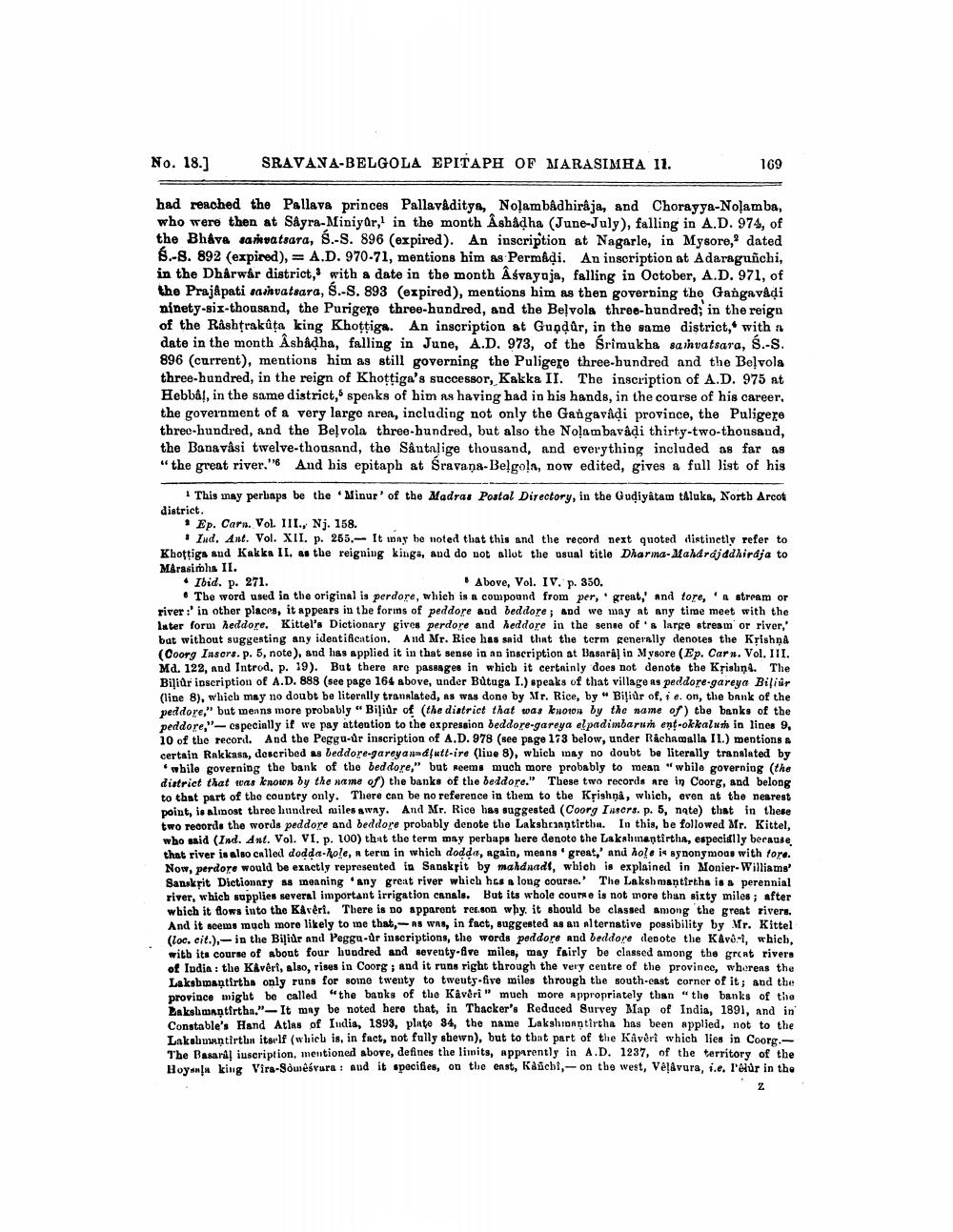________________
No. 18.]
SRAVANA-BELGOLA EPITAPH OF MARASIMHA 11.
169
had reached the Pallava princes Pallaviditya, Nolambadhiraja, and Chorayya-Nolamba, who were then at Sayra-Miniyor, in the month Ashadha (June-July), falling in A.D. 974, of the Bhava sarvatsara, S.-S. 896 (expired). An inscription at Nagarle, in Mysore, dated 6.-8. 892 (expired), = A.D. 970-71, mentions him as Permadi. An inscription at Adaragunchi, in the Dharwar district, with a date in the month Âsvayaja, falling in October, A.D. 971, of the Prajapati sa vatsara, S.-S. 893 (expired), mentions him as then governing the Gangavadi ninety-six-thousand, the Purigere three-hundred, and the Belvola three-hundred; in the reign of the Rashtrakūta king Khoţtiga. An inscription at Gu dôr, in the same district, with a date in the month Åsbadha, falling in June, A.D. 973, of the Srimukha saihvatsara, S.-S. 896 (current), mentions him as still governing the Puligere three-hundred and the Beļvola three-hundred, in the reign of Khottiga's successor, Kakka II. The inscription of A.D. 975 at Hebbal, in the same district, spenks of him as having had in his hands, in the course of his career, the government of a very large area, including not only the Gangavådi province, the Puligere three-hundred, and the Beļvola three-hundred, but also the Nolam bavadi thirty-two-thousand, the Bana vási twelve-thousand, the Såntalige thousand, and everything included as far as "the great river." And his epitaph at Sravana-Belgon, now edited, gives a full list of his
This may perhaps be the Minur' of the Madras Postal Directory, in the Gudiyatam talaka, North Arcot district.
. Ep. Carn. VOL III., Nj. 158.
Ind. Ant. Vol. XII. p. 265. It may be noted that this and the record next quoted distinctly refer to Khottiga and Kakka II, as the reigning kinga, and do not allot the usual title Dharma-Maharajddhiraja to Marasimha II. • Ibid. p. 271.
Above, Vol. IV. p. 350. . The word used in the original is perdore, which is a compound from per, 'great,' and tore,' stream or river:' in other places, it appears in the forins of peddore and beddore ; and we may at any time meet with the Inter form heddore. Kittel's Dictionary gives perdore and heddore in the sense of a large stream or river,' bat without suggesting any identification. And Mr. Rice has said that the term generally denotes the Krishna (Coorg Inscrs. p. 5, note), and has applied it in that sense in an inscription at Basaras in Mysore (Ep. Carn. Vol. III. Ma. 122, and Introd. p. 19). But there are passages in which it certainly does not denote the Krishņ4. The Billar inscription of A.D. 888 (see page 164 above, under Butuga I.) speaks of that village as peddore-gareya Bilir (line 8), which may no doubt be literally translated, as was done by Mr. Rice, by "Biļiúr of, i e. on, the bank of the peddore," but means more probably "Biļiúr of the district that was known by the name of the banks of the peddore,"- cspecially if we pay attention to the expression beddore-gareya elpadimbarun ent-okkalus in lines 9, 10 of the record. And the Peggu-ur inscription of A.D. 978 (see page 173 below, under Rachamalla 11.) mentions & certain Rakkasa, described as beddore-Jareyanedfutt-ire (line 8), which may no doubt be literally translated by
while governing the bank of the bed dore," but Reems much more probably to mean "wbile governing (the district that was known by the name of the banks of the beddore." These two records are in Coorg, and belong to that part of the country only. There can be no reference in them to the Krishna, which, even at the nearest point, is almost three hundred miles away. And Mr. Rice has suggested (Coorg Inscrs. p. 5, nate) that in these two records the words peddore and beddore probably denote the Lakshranntirthu. In this, be followed Mr. Kittel, who said (Ind. Ant. Vol. VI. p. 100) that the term may perhaps here denote the Lakshmantirtha, especially because that river is also called dodda hole, R term in which dodda, again, means 'great, and hole is synonymous with fore. Now, perdore would be exactly represented in Sanskrit by mahdnadl, which is explained in Monier-Williams' Sanskrit Dictionary as monning 'any great river which has a long course. The Lakshmantirtha is a perennial
28 several important irrigation canals. But its whole course is not more than sixty miles; after which it flows into the Kávéri. There is no apparent reason why. it should be classed among the great rivers. And it seems much more likely to me that, -as was, in fact, suggested as an alternative possibility by Mr. Kittel (loc. cit.), in the Biļidr and Peggu-ur inscriptions, the words peddore and beddore lepote the K&vol, which, with its course of about four hundred and seventy-five miles, may fairly be classed among the great rivers of India : the KAvert, also, rises in Coorg; and it runs right through the very centre of the province, whorens the Laksbmaņtirtha only runs for some twenty to tweuty-five miles through the south-east corner of it; and the province might be called "the banks of the Kaveri" much more appropriately than "the banks of the Lakshmantirtha." - It may be noted here that, in Thacker's Reduced Survey Map of India, 1891, and in Constable's Hand Atlas of India, 1893, plate 34, the name Lakshiontirtha has been applied, not to the Lakshmantirthu itself (which is, in fact, not fully sbewn), but to that part of the Kaveri which lies in Coorg - The Basara inscription, mentioned above, defines the limits, apparently in A.D. 1237, of the territory of the Hoyenu king Vira-Somesvura: And it specifies, on the east, Kaichi, on the west, Vejavura, i.e. l'Alür in the




